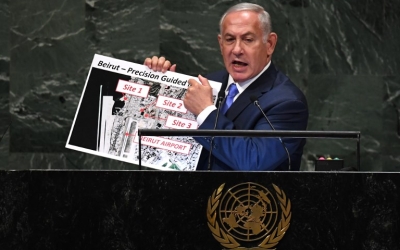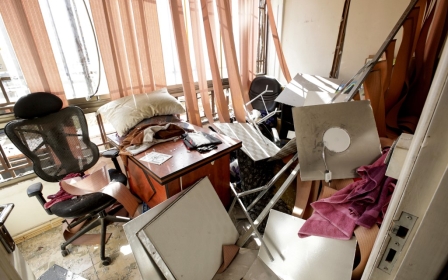Hezbollah and Israel: Deterrence at the edge of destruction

The Israeli drone attack against a Hezbollah target in a southern suburb of Beirut on 25 August, followed by a limited Hezbollah retaliation on the Israeli-Lebanese border a week later, were the first major breaches of the status quo that has prevailed between the two adversaries for the past 13 years.
They are unlikely to be the last.
Ten days after the Beirut incident, the Israeli army tweeted an aerial image showing a cluster of buildings near the town of Nabi Chit in the Bekaa Valley. According to Israel, the warehouses were sheltering Iranian equipment used to manufacture precision-guided missiles for Hezbollah. “We won’t let them,” the army vowed ominously, suggesting these facilities might be the next target.
According to Israeli sources, the 25 August operation was likewise aimed at Hezbollah’s missile programme, and succeeded in setting it back by as much as a year by destroying sophisticated Iranian equipment.
Precision-guided missiles
New MEE newsletter: Jerusalem Dispatch
Sign up to get the latest insights and analysis on Israel-Palestine, alongside Turkey Unpacked and other MEE newsletters
Hezbollah, for its part, boasts that it possesses precision-guided missiles, but denies that it seeks to develop local production capabilities. Sources close to the party say the August attack was in fact a failed assassination attempt against a high-ranking personality within Hezbollah or aligned with it.
Either way, the alleged Iranian efforts to equip Hezbollah with precision-guided missiles, and help it establish an indigenous manufacturing capability, have been a major worry for Israel for more than two years, and will likely prompt more attacks in the near future.
A recent study co-authored by Israeli and British defence experts highlights in particular mid-range missiles like the Zelzal-2, a weapon with a range of some 200 kilometres and a payload of more than 500 kilograms, of which they claim Hezbollah has 14,000 stored away.
Israel has developed advanced, multi-layered defence systems to protect itself against such threats, yet these can be overwhelmed
According to this source, a well-trained team would need roughly three hours to fit a Zelzal-2 type missile with a GPS kit, along with other modifications, at a cost of around $10,000 per missile.
By means of such an upgrade, a “dumb” projectile that follows a predictable ballistic arc and may land hundreds of meters away from the intended target when used at its maximum range, becomes a precision weapon that can be programmed to hit a pre-determined location with an accuracy of a few metres.
Israel has developed advanced, multi-layered defence systems to protect itself against missile attacks, yet these can be overwhelmed. Even the Iron Dome, Israel’s most practice-tested defence system designed to intercept short range “dumb” weapons like the Qassam rockets fired by Hamas out of Gaza and the Katyusha used by Hezbollah during the 2006 war, cannot provide complete protection.
Crucially, such defence systems rely on calculating the ballistic arc of incoming missiles to determine the site of impact, enabling them to focus interception only on those that are likely to hit valuable targets. This does not work with precision-guided missiles, which will follow a ballistic flightpath for most of their trajectory, but then change course to home in on their programmed target shortly before impact.
To offer effective protection, the defence system would therefore have to intercept all incoming missiles, a next to impossible task if the enemy resorts to swarming and combines “smart” with “dumb” missiles. “Soft” interception methods such as GPS jamming or spoofing may affect the precision systems somewhat, but remain untested and are equally unlikely to be effective against swarm attacks.
In addition, Israel’s “David's Sling” system, which has been designed to intercept medium-range missiles such as the Zelzal-2, only became operational in 2017, and did not perform as expected on the one occasion when it was activated thus far.
Avoiding confrontation
With most of Israel’s critical infrastructure concentrated in a small central area, even a few hits may be enough to paralyse the country. This is precisely the scenario that Hezbollah has highlighted for years in its public messaging to dismiss Israel's increasingly threatening rhetoric.
Hezbollah sources accept in principle that Israel has the capacity to inflict enormous damage on Lebanon. But they dismiss the likelihood of an all-out attack, or even a serious escalation, claiming that Tel Aviv is deterred by the damage Hezbollah will wreak in response.
The limited exchange of fire on the southern border that followed the 25 August drone attack appears to suggest that, in fact, both sides are still keen to avoid a confrontation.
Yet Hezbollah and Israel do not face off against one another in isolation: they are on opposite sides of the regional conflict between the US and its regional partners on one side, and Iran and its allies – the so-called “axis of resistance” - on the other. With the larger, regional conflict heating up in recent months, culminating in the 14 September attacks on Saudi oil facilities, the temperature in the eastern Mediterranean is also rising.
Hezbollah and Israel do not face off against one another in isolation
Hezbollah has left no doubt that the movement sees itself as part of this larger confrontation. According to Secretary-General Hassan Nasrallah, who recently pledged his allegiance to Iranian Supreme Leader Ali Khamenei, “War on Iran is war on all the axis of resistance. War on the Islamic Republic means the entire region will be set on fire.”
Sources close to the party have publicly indicated that if an attack on Iran were to threaten the survival of the Islamic Republic, Hezbollah would rally to Tehran’s side. In closed circles, such sources express their conviction that a Hezbollah attack on Israel that inflicts serious damage would compel the US to call off any ongoing campaign against Iran.
'North Korea playbook'
Some analysts have compared the Iranian strategy to that of North Korea, which arguably protects its nuclear programme against US strikes by holding Seoul, the capital of South Korea and home to some 150,000 US citizens, hostage to its advanced conventional artillery and missile arsenal.
According to such an alleged “North Korean playbook”, Iran’s capacity to inflict serious damage on US allies - either directly or through groups such as the Iraqi Popular Mobilisation Units, the Houthis in Yemen and Hezbollah in Lebanon - provides Tehran with significant deterrence against any military action by the US.
With Israel convinced that an ever-greater part of this retaliation/deterrence capacity is now being developed in Lebanon, the previous strategy of attacking Hezbollah’s supply lines through Syria appears no longer sufficient. To effectively disrupt production, operations will have to be launched against targets in Lebanon itself.
Yet, unlike Syria, where, thanks to its good relations with Russia, Israel can strike at a comparatively low risk, in Lebanon such attacks may trigger an escalation that Tel Aviv would rather avoid. Since the end of the 2006 war, Nasrallah has repeatedly vowed that any Israeli attack on Lebanon would meet an “appropriate” response.
Such threats arguably helped convince Israel to stand by, even as Hezbollah rebuilt and then vastly expanded its military strength. But they also put the party into a bind, compelling it to strike back if Israel does indeed attack, even if that carries the risk of escalation.
More tit-for-tats must therefore be expected, as Israel will probe different ways to disrupt Hezbollah’s alleged manufacturing programme below the threshold of outright war.
Game of chicken
Yet, resorting to tit-for-tats with missiles and drones is not an exact science with predictable outcomes. It's far closer to a game of chicken, in which he who blinks first loses face, and both find themselves in a war they claim not to seek if neither blinks.
And even the best-calibrated responses retain an element of unpredictability. Had the Hezbollah operation on 1 September managed to kill the crew of the military vehicle it attacked, a forceful Israeli response may have ensued, lifting the escalation to a higher level.
Outside actors with direct links to both sides, Russia in particular, need to stand on high alert to step in once things begin to slide out of control
Things may also easily go awry through technical error. For instance, if during such an escalation, Hezbollah attacked military installations deeper inside Israel with missile swarms, and only one projectile were to veer off course and hit a school instead, all bets would be off, and a massive Israeli counterstrike almost certain.
After 13 years of maintaining the status quo, Israel and Hezbollah are now negotiating new rules of engagement by push and shove, a dangerous dance in which one serious error may be enough to push both over the edge of mutual, if unequal, destruction.
Outside actors with direct links to both sides, Russia in particular, need to stand on high alert to step in once things begin to slide out of control. However, for the situation at the Israeli-Lebanese border to move away from the most dangerous scenarios, the regional context almost certainly would have to change.
For Israel, the prospect of having the nerve centre of its economy and infrastructure at the mercy of what are in effect Iranian missiles will remain unacceptable.
Washington’s “maximum pressure” policy, and the aggressive Iranian behaviour it provokes, add to the urgency to act on this threat. Conversely, a reduction of regional tensions could allow both sides to quietly abandon the high-risk behaviour they are now engaged in, and return to the status quo of mutual deterrence that has kept the border between Israel and Lebanon quiet for the longest it has ever been in half a century.
The views expressed in this article belong to the author and do not necessarily reflect the editorial policy of Middle East Eye.
This article is available in French on Middle East Eye French edition.
Middle East Eye delivers independent and unrivalled coverage and analysis of the Middle East, North Africa and beyond. To learn more about republishing this content and the associated fees, please fill out this form. More about MEE can be found here.







